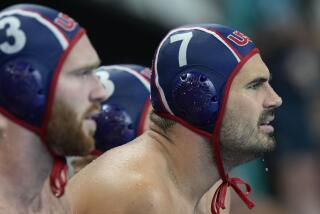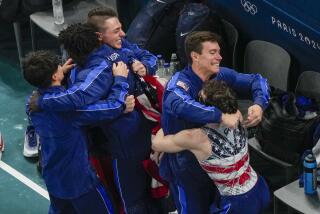A LOOK AT THE OTHER SPORTS : Post-Olympic Fortunes of U.S. Teams in Basketball, Gymnastics, Swimming, and Track and Field Are Well-Known; But what is the status of U.S. Teams in Lesser-known Sports? Here’s an Update : SHOOTING : Officials Say Big Crowds in ’84 Triggered New Plans
- Share via
R .I. Boyd is a member of the Good Ole’ Boy cognoscente who can shoot the fat with his merry fellows when the subject is guns. He can talk about hunting and target practice, or reminisce about the war.
Boyd, the technical director of international shooting for the National Rifle Assn., is comfortable among the world’s most sure-eyed shooters.
As a result, he was at home at last summer’s Olympics, which was a reunion of sorts for shooters who came not only to compete but to talk shop.
Yet, as assistant competition director at last summer’s Games, Boyd was left reeling by what transpired.
The facilities at the Prado Trio range in the Chino Valley simply could not accommodate the crowds that bulged to 10,000 a day and a media army averaging 100 reporters a day for a week.
Cramped quarters in the indoor rifle, pistol and air gun ranges made it difficult to view the events, and the abundance of spectators disturbed the shooters.
But because of this surprising interest, officials were given a new perspective on how to run a major competition.
“We had spectators out there we didn’t think existed,” Boyd said. “We didn’t know how to react to those numbers. The NRA and ISU (International Shooting Union) are looking at some of the rules and regulations that govern the conduct of tournaments. Spectator spaces. We always thought a five-foot area was plenty of room, but we now realize that’s not the case. Appropriate spectator space and appropriate press space must be made.”
The fanfare that erupted over shooting a year ago has waned tremendously.
At this summer’s national championships, also held at the Prado Trio, the number of participants was down from the past three years. Down, too, was spectator and media interest from last year.
Shooters were gunning for berths in the Confederations of the America at Ft. Benning, Ga., and the World Moving Target championships in Italy, the only major international competitions of 1985. It wasn’t much of an incentive, the shooters said.
Still, the U.S. expects to send a strong team to the 1986 World Championships at Suhl, West Germany.
Col. Lones Wiggers, a mainstay of the U.S. Rifle team since the Tokyo Games, will be competing in his last major international event if he makes the World Championship team. Chances are he will, since he won the 1985 national smallbore rifle title.
Many other athletes who have made the United States a shooting power in the last decade are expected to compete at least through the 1988 Olympics at Seoul.
The U.S. shotgun team, led by Matt Dryke, Olympic-record breaking skeet gold medalist, and Dan Carlisle, a bronze medalist in trap, is expected to remain as one of the world’s best. Dryke, the world’s premier skeet shooter, said last year that he wanted to retire from the Army in September to become a professional trick and fancy exhibition shooter, but by re-enlisting he decided to continue his amateur career.
Wiggers, a multiple medal winner in rifle competition over the last 20 years, predicted the U.S. rifle team will have some new faces for the 1986 World Championships.
Shooters to watch, he said, are Dan Durben, Bob Foth, David Johnson and Rod Fitz-Randolph. The leading women are his daughter, Deena, Pat Spurgin and Wanda Jewell.
The pistol corps, according to Dan Iuga, national team coach, is improving. Iuga, a Romanian silver medalist at the 1972 Games who defected to the West 3 1/2 years ago, said the women are one of the world’s best teams with the shooting of Ruby Fox, 1984 silver medalist, Gail Liberty and Sally Carroll. The men are led in the free pistol by Ben Amonett, Don Hamilton and Don Nygord, and in the rapid fire pistol by Steve Collins, Wayne Johnson and Terry Anderson, Iuga said.
The running boar, one of the United States’ weak points in shooting, isn’t expected to improve much, NRA officials said. Mike English, Todd Bensley and Randy Stewart continue to lead the team.
More to Read
Go beyond the scoreboard
Get the latest on L.A.'s teams in the daily Sports Report newsletter.
You may occasionally receive promotional content from the Los Angeles Times.






